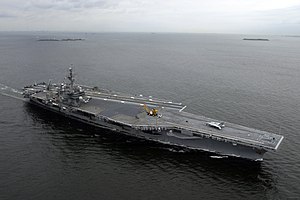 USS Kitty Hawk conducting sea trials in the Western Pacific Ocean, May 2006
| |
| Class overview | |
|---|---|
| Name | Kitty Hawk class |
| Builders | |
| Operators | |
| Preceded by | Forrestal class |
| Succeeded by | Enterprise class |
| Subclasses | John F. Kennedy class (variant) |
| In commission | 21 April 1961 – 31 January 2009 |
| Completed | 3 plus 1 variant |
| Laid up | 1 |
| Scrapped | 2 plus 1 scuttled |
| General characteristics | |
| Type | Aircraft carrier |
| Displacement |
|
| Length |
|
| Beam |
|
| Draft | 38 ft (12 m) |
| Installed power | 280,000 shp (210 MW) |
| Propulsion |
|
| Speed | 32 kn (59 km/h; 37 mph) |
| Range | 12,000 mi (19,000 km) |
| Complement | 5,624 |
| Armament |
|
| Aircraft carried | Up to 90 aircraft |
The Kitty Hawk-class supercarriers of the United States Navy were an incremental improvement on the Forrestal-class vessels. Three were built, all in the 1960s, Kitty Hawk (CV-63) (1961–2009), Constellation (CV-64) (1961–2003), and America (CV-66) (1965–1996), as well as the variant John F. Kennedy (CV-67) (1967–2007). All are now decommissioned.